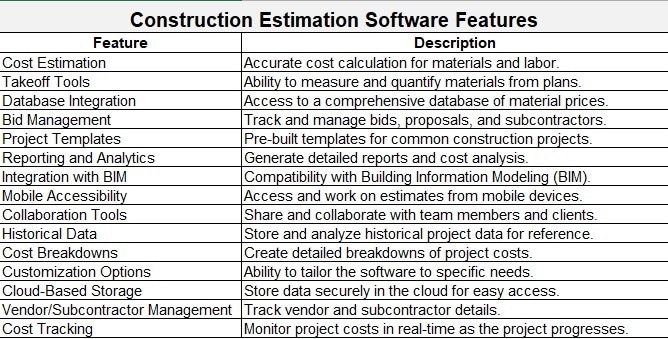In the world of construction, accurate estimation is the cornerstone of project success. Whether you are a contractor, builder, or project manager, the ability to provide precise cost estimates is crucial for winning bids, managing budgets, and ensuring the profitability of your projects. Gone are the days when estimators relied solely on manual calculations and spreadsheets; today, construction estimation software has become an indispensable tool in the industry. However, with a plethora of options available in the market, selecting the right software can be a daunting task. In this article, we will explore the key considerations you should keep in mind when choosing the right construction estimation software to meet your needs.
Understanding the Construction Estimation Process
Before delving into the intricacies of selecting the right software, it’s important to have a clear understanding of the construction pricing and estimation process itself and its pivotal role in the world of construction. Estimation involves predicting the costs, materials, and labor required for a construction project. This process begins with the examination of project plans and specifications, followed by the identification of all the elements that contribute to the project’s cost.
In the past, estimators relied heavily on manual methods, which were not only time-consuming but also prone to errors. Manual estimation involved flipping through paper plans, making manual calculations, and compiling data on spreadsheets. Such processes were not only labor-intensive but also lacked the precision that modern construction projects demand.
Cue the introduction of construction estimation software, which has revolutionized the industry. These software solutions are designed to streamline the estimation process, improve accuracy, and enhance project management. With the right software, estimators can easily generate cost estimates, perform takeoffs, and create detailed project plans. The use of software not only saves time but also minimizes errors, resulting in more competitive bids and more successful projects.
Types of Construction Estimation Software
Once you recognize the importance of construction estimation software, the next step is to understand the different types available. Construction estimation software comes in various forms, each catering to specific needs and preferences.
Cloud-Based vs. Desktop-Based Software:
One fundamental distinction lies in the deployment method: cloud-based or desktop-based. Cloud-based software, also known as Software as a Service (SaaS), operates entirely online and can be accessed from anywhere with an internet connection. In contrast, desktop-based software is installed on a local computer and runs offline.
Cloud-based solutions offer the advantage of accessibility and collaboration. They enable team members to work on estimates from different locations and devices while ensuring that everyone is working on the latest version of the software. Desktop-based software, on the other hand, can be preferred for its offline capabilities and potentially faster performance, especially for larger projects.
Specialized vs. All-in-One Solutions:
Another key consideration is whether to opt for specialized software or all-in-one construction management suites. Specialized software focuses solely on estimation and takeoff capabilities, offering a narrow but deep set of features tailored for estimators. In contrast, all-in-one solutions encompass a broader range of construction management tools, including estimating, project management, scheduling, and accounting.
The choice between specialized and all-in-one software depends on your specific needs. Specialized software can be ideal if you want to focus solely on the estimation process and have existing tools for project management. All-in-one solutions offer the convenience of having multiple construction-related functions integrated into a single platform, which can improve workflow efficiency and communication among project stakeholders.
Essential Features to Look for

Having a clear understanding of the types of construction estimation software is essential, but it’s equally crucial to know what specific features to look for in these tools. The following are some of the essential features that should be on your checklist:
Cost Databases and Libraries:
Look for software that provides access to comprehensive cost databases and libraries. These databases should include up-to-date pricing information for materials, labor, and equipment specific to your region.
The ability to customize and add your own cost data is also valuable, as it allows you to reflect your unique project requirements.
Construction Takeoff Tools:
Takeoff tools are essential for accurately quantifying materials and labor requirements from digital project plans.
The software should enable you to easily measure lengths, areas, and volumes, and provide tools for annotating and marking up plans.
Integration with digital blueprints and the ability to import and export data are important for seamless workflow.
Integration Capabilities:
Consider software that offers integration with other construction management tools, such as project scheduling, accounting, and project management software.
Integration ensures that data flows smoothly between different stages of your construction projects, reducing data entry errors and improving overall project efficiency.
Customization Options:
The ability to customize templates, reports, and cost structures is valuable for tailoring the software to your specific needs and branding.
Look for software that allows you to create reusable templates for different types of projects, saving time and ensuring consistency.
Reporting and Analytics:
Robust reporting and analytics features are essential for gaining insights into your estimates, identifying cost trends, and making data-driven decisions.
Look for software that provides customizable reports and dashboards, allowing you to present information in a format that suits your needs.
Compatibility and Integration
Construction estimation software doesn’t operate in isolation; it needs to work seamlessly with your existing systems and tools. Compatibility and integration are key factors to consider:
Compatibility with Existing Systems:
Ensure that the software you choose is compatible with your existing hardware and operating systems.
Check whether it can import and export data in formats that your team commonly uses.
Integration with Other Construction Tools:
Look for software that offers integration with widely used construction management tools, such as project scheduling, accounting, and project management software.
Integration eliminates the need for manual data entry and allows for real-time data synchronization.
Data Backup and Security:
Data security is paramount. Ensure that the software provider has robust security measures in place to protect your sensitive project data.
Regular data backups and the ability to restore data in case of unexpected incidents should also be considered.
User-Friendliness and Training
The usability of the software plays a crucial role in its adoption within your organization:
User-Friendly Interface:
The software should have an intuitive and user-friendly interface to minimize the learning curve for your team.
Consider software that provides tutorials, tooltips, and context-sensitive help to assist users.
Training and Support:
Investigate the availability of training and support resources provided by the software vendor.
Look for vendors that offer training sessions, user manuals, and responsive customer support to assist with any issues.
Pilot Testing:
Before committing to a software solution, conduct pilot tests with a small team to evaluate how well it aligns with your workflow and requirements.
Cost Considerations
Cost is a significant factor when choosing construction estimation software:
Licensing and Subscription Costs:
Understand the pricing structure, whether it’s based on one-time licensing fees or subscription models.
Consider whether the pricing scales with the number of users or projects.
Additional Costs:
Be aware of any additional costs, such as support fees, updates, or customization charges.
Calculate the total cost of ownership over the software’s expected lifespan.
Return on Investment (ROI):
Evaluate the potential ROI of the software by considering how it can improve accuracy, efficiency, and the competitiveness of your bids.
Compare the expected benefits to the total cost to determine the software’s value.
Scalability and Future-Proofing
Selecting software that can grow with your business and adapt to changing industry standards is crucial:
Scalability
Assess whether the software can handle larger and more complex projects as your business expands.
Consider the ease of adding new users and scaling up your usage.
Software Update:
Check the vendor’s track record for providing regular updates and improvements to the software.
Ensure that the software remains compliant with industry standards and regulations.
Long-Term Vendor Support
Choose a reputable vendor with a history of providing long-term support and a commitment to customer satisfaction.
Case Studies and User Reviews
Gathering real-world insights can be invaluable when making your decision:
Case Studies:
Seek out case studies of construction companies that have successfully implemented the software you are considering.
Case studies can provide insights into the software’s practical benefits and its impact on real projects.
User Reviews and Testimonials:
Look for user reviews and testimonials from professionals in the construction industry who have experience with the software.
User feedback can reveal strengths and weaknesses that may not be evident in vendor marketing materials.
Industry Resources:
Explore industry-specific websites, forums, and associations for recommendations and discussions about construction estimation software.
Security and Data Protection
Construction estimation software deals with sensitive project data, so security is paramount:
Data Encryption
Ensure that the software employs encryption to protect data during transmission and storage.
Look for industry-standard encryption protocols to safeguard your information.
Data Access Controls
Verify that the software provides role-based access controls to restrict who can view and edit sensitive project information.
Compliance and Certification
Check if the software complies with industry-specific regulations and certifications related to data security.
Making the Final Decision
After considering all the factors mentioned above, it’s time to make your final decision:
Recap of Key Considerations:
Summarize the essential factors you’ve assessed in choosing construction estimation software.
Step-by-Step Decision-Making Guide:
Offer readers a step-by-step guide to help them make an informed decision based on their unique requirements and priorities.
Free Trials and Demos:
Encourage readers to take advantage of free trials or demos offered by software vendors to get hands-on experience before committing.
Selecting the right construction estimation software is a critical decision that can significantly impact the success of your projects. By understanding the construction estimation process, evaluating essential features, considering compatibility and integration, prioritizing user-friendliness, and carefully weighing costs, scalability, and security, you can make a well-informed choice that benefits your construction business in the long run. Remember that the right software can streamline processes, enhance accuracy, and ultimately contribute to the success and profitability of your construction projects.
Looking for assistance with construction pricing and estimation? Contact us today.















